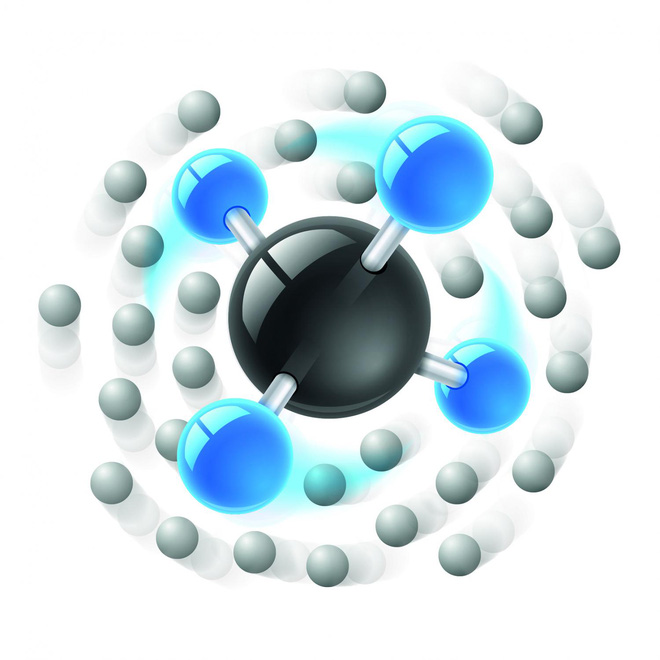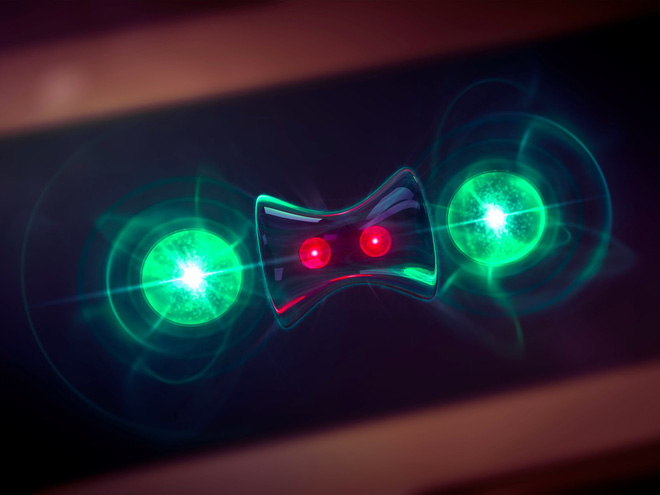Science has found evidence of the immortality of pseudo-particles: they replicate themselves after decay
Nothing exists forever. Humans, planets, stars, galaxies . maybe even the Universe itself, everything perish in accordance with the cycle of birth - death. But that rule does not necessarily exist in the quantum world because recently, scientists have discovered quasiparticle in many quantum systems that can literally immortal.
The quasiparticles are not a seed of electrons or quarks that we know of. They are just a disturbance taking place inside matter, created by the electric or magnetic force in the solid and acting like particles. While a particle (electron, proton or neutron) can freely float in space, a pseudo-particle can exist only in systems interacting between many particles (mostly solids).

Pseudo-immortals still undergo decay, but the strange thing is that after decaying, they can reorganize themselves back to their original state.
This seems to be challenging the second law of thermodynamics, asserting that entropy in an isolated system can only increase but not decrease: everything can only be broken, not built by itself. rebuild. However, the discovery of immortal particles does not cause scientists headaches, because humanity still knows too little about the quantum world - where the laws go against the physical model. tissue we still know.
We all know that the strong interaction is the binding force between quarks, the particles that make up the atomic nucleus, which holds protons and neutrons in the nucleus together. With some heavy elemental nuclei, some neutrons are isolated from the proton, causing the nucleus to decay. But in June 2019, physicist Frank Pollman of Munich Technical University again discovered something strange: "Previously, we assumed that pseudo-particles in quantum systems, the interaction decays after a for a while, but now we know one more thing: the strong interactions can even stop the nucleus from completely decaying. "
The scientists involved in the study developed arithmetic models to calculate the complex interactions of pseudo-particles, then ran simulations on a supercomputer to observe how they decay.
" After seeing the results of the simulation, we have to admit that the pseudo-particles decay, but then identical particle entities appear from the debris ," said physicist Ruben Verresen. of Munich Technical University and Max Planck's Institute of Physics.
"If decay takes place at a super fast speed, an inverse reaction will occur after a certain amount of time and the debris will converge. This process can recur infinitely creating a knife. action between decay and rebirth. "
And finally physicists have shown that it doesn't violate the second law of thermodynamics. Because the oscillation is a wave transformed into matter, this is described by the concept of wave-particle duality, a content contained in quantum mechanics. Besides, the entropy of quantum systems containing pseudo-particles does not decrease, they remain the same. While this is strange, it does not break the laws of physics.

In fact, this finding has solved several other problems. In previous experiments, the magnetic compound Ba 3 CoSb 2 O 9 had an unstable structure, but now the magnetic particles included in this substance (called magnons) are missing links. to decode this phenomenon. According to computer simulations, they have rearranged themselves after decay.
In addition, physicists have also deciphered the phenomenon of helium becoming a superfluid liquid at an absolute low temperature of -273.15 ° C, and this transition can be explained by the fact that helium is also full. The pseudo-particle is called roton.
At present, these findings are theoretical, but researchers believe that the immortality of pseudo-particles will provide the potential for long-term data storage in quantum computer systems.
The research has been published in Nature.
You should read it
- Successful fabrication of quantum compass to atomic level, replacing GPS in the future
- New chip technology can enhance quantum computing
- For the first time, scientists have successfully implemented quantum shifts between two chips
- Quantum computing - a marathon, not a sprint contest!
- China successfully developed 'handheld' quantum satellite communications equipment
- The concept of PC will be replaced by QC
- Quantum physics provides new knowledge about the brain
- Quantum computing will become Amazon's key business service
May be interested
- How strong a magnetic field can 'tear' you into subatomic particles?
 it happens when all the positively charged particles in your body are pulled in one direction, and the negatively charged particles are pulled in the opposite direction.
it happens when all the positively charged particles in your body are pulled in one direction, and the negatively charged particles are pulled in the opposite direction. - Found evidence of Sun storm in wood rings
 scientists have recently demonstrated that the tree's rings still contain evidence of past solar storms. from there, it is possible to define in detail the dates of ancient egypt, the mayan civilization or the bronze age.
scientists have recently demonstrated that the tree's rings still contain evidence of past solar storms. from there, it is possible to define in detail the dates of ancient egypt, the mayan civilization or the bronze age. - What will happen to our body if the Sun suddenly disappears?
 have you ever wondered how our bodies will change when the sun no longer exists? let us find out in that article below!
have you ever wondered how our bodies will change when the sun no longer exists? let us find out in that article below! - Top 10 mysteries have been decoded by scientists
 today with modern science and technology, scientists have found evidence and explain some of the great mysteries of humanity: the cause of the destruction of mayan civilization, the process of building kim. egyptian pyramid, the exact location of the ship columbus used when exploring america ...
today with modern science and technology, scientists have found evidence and explain some of the great mysteries of humanity: the cause of the destruction of mayan civilization, the process of building kim. egyptian pyramid, the exact location of the ship columbus used when exploring america ... - Find out about Virus.Win32.Sality.ag template
 viruses like these often have a mechanism to replicate the resources on the infected computer, unlike worms, unused viruses and exploit network services to replicate and spread themselves to other computers ..
viruses like these often have a mechanism to replicate the resources on the infected computer, unlike worms, unused viruses and exploit network services to replicate and spread themselves to other computers .. - How to Get the Amulet of Immortality and What It Really Does in Minecraft
 the amulet of immortality is the only life-saving item in minecraft. it only works when held in the main or off-hand.
the amulet of immortality is the only life-saving item in minecraft. it only works when held in the main or off-hand. - The lost twin brothers of the Sun may be the culprits for the destruction of dinosaurs
 the group of american astronomers has found evidence of the existence of a twin planet with the sun, which once caused great catastrophe on earth. let us find out about the lost twin brother of the sun who may be the culprit of this dinosaur destruction!
the group of american astronomers has found evidence of the existence of a twin planet with the sun, which once caused great catastrophe on earth. let us find out about the lost twin brother of the sun who may be the culprit of this dinosaur destruction! - The superconducting scientific report is controversial, if it is wrong it will be a famous scam, if it is true it will change the world
 last july, two renowned chemical physicists from the indian institute of science in bangalore, dev thapa and anshu pandey, reported that they had used a matrix of gold and silver particles to create superconductivity at room temperature with pressure.
last july, two renowned chemical physicists from the indian institute of science in bangalore, dev thapa and anshu pandey, reported that they had used a matrix of gold and silver particles to create superconductivity at room temperature with pressure. - Reveal the best place to find life on Mars
 nasa's spirit self-propelled robot has found evidence of life on mars before being trapped in a sand pit and confirmed to disappear by nasa in 2010? it can be said that two geographers have identified a position on earth formed by microorganisms that closely resemble a specific area of mars observed carefully by self-propelled robots in 2007.
nasa's spirit self-propelled robot has found evidence of life on mars before being trapped in a sand pit and confirmed to disappear by nasa in 2010? it can be said that two geographers have identified a position on earth formed by microorganisms that closely resemble a specific area of mars observed carefully by self-propelled robots in 2007. - The oldest Italian wine in the world is found
 researchers have found evidence of the oldest italian wine in the world in bronze age containers, suggesting that wine production may begin in the early 4th century bc.
researchers have found evidence of the oldest italian wine in the world in bronze age containers, suggesting that wine production may begin in the early 4th century bc.










 Physicists calculate the number of years we need to travel interstellar, so large that you will sigh boredom
Physicists calculate the number of years we need to travel interstellar, so large that you will sigh boredom Rumor: Marvel could buy rival DC Comics
Rumor: Marvel could buy rival DC Comics Doctor of Philosophy of Science: We may have discovered traces of aliens already, we just don't know what it is.
Doctor of Philosophy of Science: We may have discovered traces of aliens already, we just don't know what it is. New research finds that seagulls are becoming more and more 'hungry': they are bored with grouper.
New research finds that seagulls are becoming more and more 'hungry': they are bored with grouper. Science has discovered giant viruses with the ability to 'steal' other species' characteristics
Science has discovered giant viruses with the ability to 'steal' other species' characteristics Elon Musk wary: Experts warn low-cost satellites to flood the Earth's orbit will be a 'lucrative' target for hackers
Elon Musk wary: Experts warn low-cost satellites to flood the Earth's orbit will be a 'lucrative' target for hackers